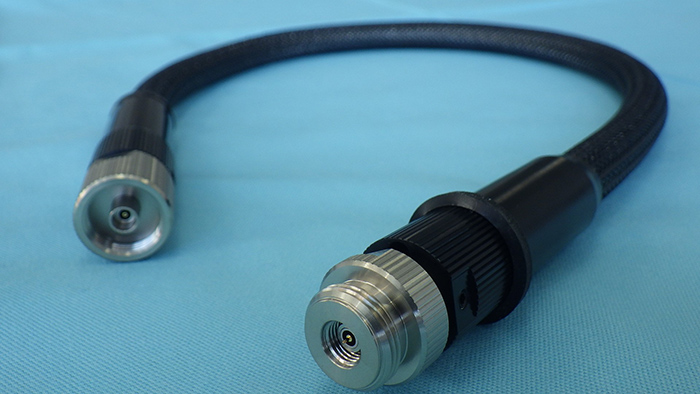The importance of innovative cabling in VNAs and probe stations
Cables and connectors are at the core of today’s sophisticated operating systems. As we shift our focus to the technology of tomorrow and move towards a 5G-enabled world, cables and interconnects must be of the highest standard and reliability. This article examines two key application areas: Vector Network Analysers (VNAs) and Probe Stations. Masaru Omoto of Junkosha explains more.
Advancements in 5G have brought into play higher mmWave frequencies where cabling and interconnect solutions must be of the highest quality to withstand the rigour they are subjected to in any given scenario. This may be in the system development or device characterisation phases where precision and repeatability are required, or in the stages of commissioning the overall system and monitoring within the production test environment.
Cabling assemblies deployed in a test environment are often utilised alongside Vector Network Analysers (VNAs), which are used to test and characterise components to ensure systems function properly together. At mmWave’s miniaturised wavelengths, instances of flexure and movement have a significant impact on the accuracy of results, which is accentuated as frequencies increase.
Accuracy is crucial in any test setting, but particularly so for metrology grade cabling, which offers ultimate precision and therefore demands the highest reliability for testing and calibration purposes. In response, global cabling and interconnect pioneers, Junkosha, are launching their new microwave/mmWave VNA test cable assembly – designed as a high-quality metrology grade VNA test cable for those requiring optimum precision. This latest innovation builds on the foundations of the Junkosha 0 Series and shares the same core principles.
Utilising Junkosha’s expanded-PTFE tape wrapping technology, the new cable exhibits phase and amplitude stability in flexure alongside strong phase stability in temperature. Able to reach 50GHz and available in a 2.4mm connector, the assembly also displays impressive performance durability – 50,000 tick tock cycles is typical. A ruggedised port side NMD connector is also available to ensure reliable connections to the VNA.
The key application area for the new metrology grade microwave/mmWave VNA test cable assembly is in measuring the device under test (DUT) when designing a high frequency component from scratch. This metrology grade cable will also be used for coaxial cable development, as well as cable products. Offering a calibration level standard bench test, target customers for the new solution include top-level national institutes, calibration laboratories and service providers where repeatability is key.
The demand for mmWave frequencies has gone from the preserve of the few to the requirement of many, thanks to varied new applications ranging from space and defence to commercial. To enable systems to deliver the required outputs at the higher mmWave frequency, ‘phase performance that endures’ is a statement that the cabling and interconnects used must live up to, especially in the test and measurement environment.

Above: Junkosha’s latest interconnects provide VNA manufacturers with the capability to test high-frequency networks that are at the heart of tomorrow’s highly sophisticated systems
In a 5G future where both humans and devices will require constant wireless connectivity, the world demands increased network capacity. This calls for both an amplification of, and more efficient use of, the available frequency spectrum through the application of innovative technologies.
Probe stations allow a user to position electrical, optical or RF probes on a silicon wafer and connect them to a Vector Network Analyzer (VNA) so that the device can be tested. Using high-end cabling in a probe station is crucial: cables must be low loss, lightweight and both phase and amplitude stable against temperature, flexure and vibration. This is because once calibrated, the cable must function accurately for a long period of time. If the cable is not phase stable, it can quickly degrade a system, producing inaccurate data and requiring regular re-calibration.
Though armoured cables can improve amplitude and phase stability, they are generally considered too heavy for probe stations as they are incompatible with the positional sensitivity of the probe tips and can offset the system mechanics if moved incorrectly.
A further important consideration is the connectors, which help to keep the probe tip (which requires micrometre accuracy) stable. Many applications require bending in the cable, which makes the angle of the connector crucial in ensuring the probe tip is kept in position.
According to research by Industry Today, the global high-frequency probe station market will be worth $1176.3m by 2025, rising from $793.8m in 2019 – an expansion primarily driven by an increase in 5G deployment. As 5G continues to be rolled-out, applications requiring high quality microchips increase and so the need for probe stations to test chips packaged together rises in importance. Indeed, in wafer probe testing, chips are mounted together and tested for functionality as a complete solution.
With chips operating at higher frequencies, cables must transfer the signals onto and out of the chips at a faster rate. To meet this requirement, good quality cables are essential. The benefit of Junkosha’s cabling is its ePTFE tape wrapped dielectric layer, which can be controlled for tension, thickness, mechanical ability and flexibility. The Junkosha 001 cable assembly features low insertion loss when measuring applications requiring flexibility.
Cable insertion loss is minimised due to its cable structure, which is optimised for measurement up to 110GHz. MWX001 also exhibits phase stability, signal transmission and form-sustainability. A Safety-Lock mechanism is available to ensure that the 1.0mm(m) connector pin is inserted into the female connector safely and securely.
Alongside radar, space and defence sectors, the key application area for MWX001 is 5G. Bringing reduced latency and improved data rates, 5G is designed to interconnect devices, machines, and people closer than ever before – known as the Internet of Things (IoT). This enables a future of advanced technology including autonomous vehicles, smart cities, and virtual reality – each bringing more sophisticated chipsets and thus increasing the requirement for efficient probe station testing and high-end cabling.


